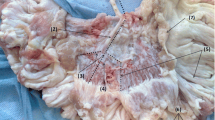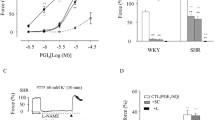Abstract
P2X1 receptors, the major subtype of P2X receptors in the vascular smooth muscle, are essential for α,β-methylene adenosine 5′-triphosphate (α,β-MeATP)-induced vasoconstriction. However, relative physiological significance of P2X1 receptor-regulated vasoconstriction in the different types of arteries in the rat is not clear as compared with α1-adrenoceptor-regulated vasoconstriction. In the present study, we found that vasoconstrictive responses to noncumulative administration of α,β-MeATP in the rat isolated mesenteric arteries were significantly smaller than those to single concentration administration of α,β-MeATP. Therefore, we firstly reported the characteristic of α,β-MeATP-regulated vasoconstrictions in rat tail, internal carotid, pulmonary, mesenteric arteries, and aorta using single concentration administration of α,β-MeATP. The rank order of maximal vasoconstrictions for α,β-MeATP (E max·α,β-MeATP) was the same as that of maximal vasoconstrictions for noradrenaline (E max·NA) in the internal carotid, pulmonary, mesenteric arteries, and aorta. Moreover, the value of (E max·α,β-MeATP/E max·KCl)/(E max·NA/E max·KCl) was 0.4 in each of the four arteries, but it was 0.8 in the tail artery. In conclusion, P2X1 receptor-mediated vasoconstrictions are equally important in rat internal carotid, pulmonary, mesenteric arteries, and aorta, but much greater in the tail artery, suggesting its special role in physiological function.






Similar content being viewed by others
References
Kennedy C, Saville VL, Burnstock G (1986) The contributions of noradrenaline and ATP to the response of the rabbit central ear artery to sympathetic nerve stimulation depend on the parameters of stimulation. Eur J Pharmacol 122:291–300
Burnstock G, Warland JJ (1987) A pharmacological study of the rabbit saphenous artery in vitro: a vessel with a large purinergic contractile response to sympathetic nerve stimulation. Br J Pharmacol 90:111–120
Brizzolara AL, Burnstock G (1990) Evidence for noradrenergic–purinergic cotransmission in the hepatic artery of the rabbit. Br J Pharmacol 99:835–839
Ren LM, Burnstock G (1997) Prominent sympathetic purinergic vasoconstriction in the rabbit splenic artery: potentiation by 2,2′-pyridylisatogen tosylate. Br J Pharmacol 120:530–536
Bo X, Burnstock G (1993) Heterogeneous distribution of [3H]α, β-methylene ATP binding sites in blood vessels. J Vasc Res 30:87–101
Ramme D, Regenold JT, Starke K, Busse R, Illes P (1987) Identification of the neuroeffector transmitter in jejunal branches of rabbit mesenteric artery. Naunyn–Schmiedeberg’s Arch Pharmacol 336:267–273
Boarder MR, Hourani SM (1998) The regulation of vascular function by P2 receptors: multiple sites and multiple receptors. Trends Pharmacol Sci 19:99–107
Valera S, Hussy N, Evans RJ, Adami N, North RA, Surprenant A, Buell G (1994) A new class of ligand-gated ion channel defined by P2X receptor for extracellular ATP. Nature 371:516–519
Collo G, North RA, Kawashima E, Merlo-Pich E, Neidhart S, Surprenant A, Buell G (1996) Cloning of P2X5 and P2X6 receptors and the distribution and properties of an extended family of ATP-gated ion channels. J Neurosci 16:2495–2507
Galligan JJ, Hess MC, Miller SB, Fink GD (2001) Differential localization of P2 receptor subtypes in mesenteric arteries and veins of normotensive and hypertensive rats. J Pharmacol Exp Ther 296:478–485
Vial C, Evans RJ (2002) P2X1 receptor-deficient mice establish the native P2X receptor and a P2Y6-like receptor in arteries. Mol Pharmacol 62:1438–1445
Erlinge D, Burnstock G (2008) P2 receptors in cardiovascular regulation and disease. Purinergic Signal 4:1–20
Steinmetz M, Bierer S, Hollah P, Rahn KH, Schlatter E (2000) Heterogenous vascular effects of AP5A in different rat resistance arteries are due to heterogenous distribution of P2X and P2Y1 purinoceptors. J Pharmacol Exp Ther 294:1182–1187
Malmsjö M, Bergdahl A, Möller S, Zhao XH, Sun XY, Hedner T, Edvinsson L, Erlinge D (1999) Congestive heart failure induces downregulation of P2X1-receptors in resistance arteries. Cardiovasc Res 43:219–227
Wihlborg AK, Slätt J, Sun X, Zhao XH, Malmsjö M, Bergman J, Hedner T, Erlinge D (2003) 2,2′-Nitrophenylisatogen potentiates P2X1 receptor mediated vascular contraction and blood pressure elevation. Drug Dev Res 59:82–87
Liu SF, McCormack DG, Evans TW, Barnes PJ (1989) Characterization and distribution of P2-purinoceptor subtypes in rat pulmonary vessels. J Pharmacol Exp Ther 251:1204–1210
Mombouli JV, Vanhoutte PM (1993) Purinergic endothelium-dependent and -independent contractions in rat aorta. Hypertension 22:577–583
O’Connor SE, Wood BE, Leff P (1990) Characterization of P2x -receptors in rabbit isolated ear artery. Br J Pharmacol 101:640–644
Zhao D, Ren LM (2005) Non-adrenergic inhibition at prejunctional sites by agmatine of purinergic vasoconstriction in rabbit saphenous artery. Neuropharmacology 48:597–606
Zhao D, Ren LM, Lu HG, Zhang X (2008) Potentiation by yohimbine of α-adrenoceptor-mediated vasoconstriction in response to clonidine in the rabbit ear vein. Eur J Pharmacol 589:201–205
Park JY, Shin HK, Lee YJ, Choi YW, Bae SS, Kim CD (2009) The mechanism of vasorelaxation induced by Schisandra chinensis extract in rat thoracic aorta. J Ethnopharmacol 121:69–73
Oriowo MA, Chandrasekhar B, Kadavil EA (2003) α1-Adrenoceptor subtypes mediating noradrenaline-induced contraction of pulmonary artery from pulmonary hypertensive rats. Eur J Pharmacol 482:255–263
Massett MP, Lewis SJ, Bates JN, Kregel KC (1998) Effect of heating on vascular reactivity in rat mesenteric arteries. J Appl Physiol 85:701–708
Jähnichen S, Eltze M, Pertz HH (2004) Evidence that α1B-adrenoceptors are involved in noradrenaline-induced contractions of rat tail artery. Eur J Pharmacol 488:157–167
Leff P, Wood BE, O’Connor SE (1990) Suramin is a slowly-equilibrating but competitive antagonist at P2X-receptors in the rabbit isolated ear artery. Br J Pharmacol 101:645–649
Burnstock G, Kennedy C (1985) Is there a basis for distinguishing two types of P2-purinoceptor? Gen Pharmacol 16:433–440
Ren LM, Zhang M (2002) Distribution of functional P2X1-like receptor in isolated rabbit arteries. Acta Pharmacol Sin 23:721–726
Muramatsu I, Ohmura T, Kigoshi S, Hashimoto S, Oshita M (1990) Pharmacological subclassification of α-adrenoceptors in vascular smooth muscle. Br J Pharmacol 99:197–201
Chootip K, Ness KF, Wang Y, Gurney AM, Kennedy C (2002) Regional variation in P2 receptor expression in the rat pulmonary arterial circulation. Br J Pharmacol 137:637–646
Vails AJ, Crowe R, Burnstock G (1997) A neuromodulatory role for neuronal nitric oxide in the rabbit renal artery. Br J Pharmacol 121:213–220
Bo X, Sexton A, Xiang Z, Nori SL, Burnstock G (1998) Pharmacological and histochemical evidence for P2X receptors in human umbilical vessels. Eur J Pharmacol 353:59–65
Garcia-Villalon AL, Garcia JL, Fernandez N, Monge L, Gomez B, Dieguez G (1996) Regional differences in the arterial response to vasopressin: role of endothelial nitric oxide. Br J Pharmacol 118:1848–1854
Nori S, Fumagalli L, Bo X, Bogdanov Y, Burnstock G (1998) Coexpression of mRNAs for P2X1, P2X2 and P2X4 receptors in rat vascular smooth muscle: an in situ hybridization and RT-PCR study. J Vasc Res 35:179–185
Ralevic V, Burnstock G (1998) Receptors for purines and pyrimidines. Pharmacol Rev 50:413–492
Hansen MA, Dutton JL, Balcar VJ, Barden JA, Bennett MR (1999) P2X (purinergic) receptor distributions in rat blood vessels. J Auton Nerv Syst 75:147–155
Brake AJ, Wagenbach MJ, Julius D (1994) New structural motif for ligand-gated ion channels defined by an ionotropic ATP receptor. Nature 371:519–523
Wallace A, Knight GE, Cowen T, Burnstock G (2006) Changes in purinergic signalling in developing and ageing rat tail artery: importance for temperature control. Neuropharmacology 50:191–208
Rand RP, Burton AC, Ing T (1965) The tail of the rat, in temperature regulation and acclimatization. Can J Physiol Pharmacol 43:257–267
Raman ER, Vanhuyse VJ, Roberts MF (1987) Mathematical circulation model for the blood-flow–heat-loss relationship in the rat tail. Phys Med Biol 32:859–875
Ajay M, Achike FI, Mustafa MR (2007) Modulation of vascular reactivity in normal, hypertensive and diabetic rat aortae by a non-antioxidant flavonoid. Pharmacol Res 55:385–391
Yu J, Tokinaga Y, Kuriyama T, Uematsu N, Mizumoto K, Hatano Y (2005) Involvement of Ca2+ sensitization in ropivacaine-induced contraction of rat aortic smooth muscle. Anesthesiology 103:548–555
Acknowledgements
This work was supported by a grant from the National Program on Key Basic Research Project of China (973 Program; No. 2005CB523301).
Conflicts of interest
None
Author information
Authors and Affiliations
Corresponding author
Rights and permissions
About this article
Cite this article
Li, L., Jia, ZH., Chen, C. et al. Physiological significance of P2X receptor-mediated vasoconstriction in five different types of arteries in rats. Purinergic Signalling 7, 221–229 (2011). https://doi.org/10.1007/s11302-011-9226-y
Received:
Accepted:
Published:
Issue Date:
DOI: https://doi.org/10.1007/s11302-011-9226-y




